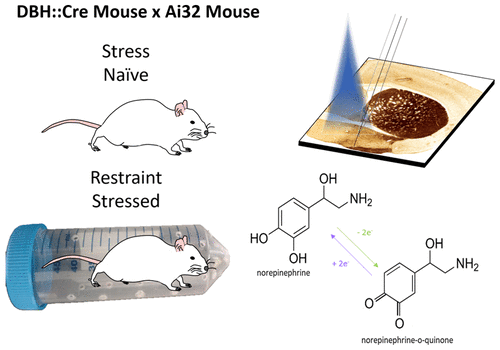当前位置:
X-MOL 学术
›
ACS Chem. Neurosci.
›
论文详情
Our official English website, www.x-mol.net, welcomes your
feedback! (Note: you will need to create a separate account there.)
Stress-Induced Alterations of Norepinephrine Release in the Bed Nucleus of the Stria Terminalis of Mice.
ACS Chemical Neuroscience ( IF 4.1 ) Pub Date : 2018-09-28 , DOI: 10.1021/acschemneuro.8b00265 Karl T Schmidt , Viren H Makhijani , Kristen M Boyt , Elizabeth S Cogan , Dipanwita Pati , Melanie M Pina , Isabel M Bravo , Jason L Locke 1 , Sara R Jones 1 , Joyce Besheer , Zoé A McElligott
ACS Chemical Neuroscience ( IF 4.1 ) Pub Date : 2018-09-28 , DOI: 10.1021/acschemneuro.8b00265 Karl T Schmidt , Viren H Makhijani , Kristen M Boyt , Elizabeth S Cogan , Dipanwita Pati , Melanie M Pina , Isabel M Bravo , Jason L Locke 1 , Sara R Jones 1 , Joyce Besheer , Zoé A McElligott
Affiliation

|
Stress can drive adaptive changes to maintain survival during threatening stimuli. Chronic stress exposure, however, may result in pathological adaptations. A key neurotransmitter involved in stress signaling is norepinephrine. Previous studies show that acute stress elevates norepinephrine levels in the bed nucleus of the stria terminalis (BNST), a critical node regulating anxiety and upstream of stress responses. Here, we use mice expressing channelrhodopsin in norepinephrine neurons to selectively activate terminals in the BNST, and measure norepinephrine release with optogenetics-assisted fast-scan cyclic voltammetry (FSCV). We demonstrate that while corticosterone habituates to chronic restraint stress, cFos activation of medullary norepinephrine neurons shows equivalent activation under both acute and chronic stress conditions. Mice exposed to a single restraint session show an identical optically stimulated norepinephrine release profile compared to that of unexposed mice. Mice experiencing 5 days of restraint stress, however, show elevated norepinephrine release across multiple stimulation parameters, and reduced sensitivity to the α2-adrenergic receptor (AR) antagonist idazoxan. These data are the first to examine norepinephrine release in the BNST to tonic and phasic stimulation frequencies, and confirm that repeated stress alters autoreceptor sensitivity.
中文翻译:

应激引起的小鼠终纹床核中去甲肾上腺素释放的改变。
压力可以驱动适应性变化,以在受到威胁的刺激下维持生存。然而,慢性压力暴露可能会导致病理适应。参与压力信号传导的关键神经递质是去甲肾上腺素。先前的研究表明,急性压力会提高终纹床核 (BNST) 中的去甲肾上腺素水平,BNST 是调节焦虑和压力反应上游的关键节点。在这里,我们使用在去甲肾上腺素神经元中表达视紫红质的小鼠来选择性激活 BNST 中的终端,并使用光遗传学辅助快速扫描循环伏安法 (FSCV) 测量去甲肾上腺素的释放。我们证明,虽然皮质酮习惯于慢性束缚压力,但髓质去甲肾上腺素神经元的 cFos 激活在急性和慢性压力条件下显示出等效的激活。与未暴露的小鼠相比,暴露于单一约束会话的小鼠显示出相同的光刺激去甲肾上腺素释放曲线。然而,经历 5 天束缚压力的小鼠在多个刺激参数中表现出升高的去甲肾上腺素释放,并降低对 α2-肾上腺素能受体 (AR) 拮抗剂咪唑克生的敏感性。这些数据是第一个检查 BNST 中去甲肾上腺素释放到强直和相位刺激频率的数据,并确认重复压力会改变自身感受器的敏感性。和降低对 α2-肾上腺素能受体 (AR) 拮抗剂咪唑克生的敏感性。这些数据是第一个检查 BNST 中去甲肾上腺素释放到强直和相位刺激频率的数据,并确认重复压力会改变自身感受器的敏感性。和降低对 α2-肾上腺素能受体 (AR) 拮抗剂咪唑克生的敏感性。这些数据是第一个检查 BNST 中去甲肾上腺素释放到强直和相位刺激频率的数据,并确认重复压力会改变自身感受器的敏感性。
更新日期:2018-09-25
中文翻译:

应激引起的小鼠终纹床核中去甲肾上腺素释放的改变。
压力可以驱动适应性变化,以在受到威胁的刺激下维持生存。然而,慢性压力暴露可能会导致病理适应。参与压力信号传导的关键神经递质是去甲肾上腺素。先前的研究表明,急性压力会提高终纹床核 (BNST) 中的去甲肾上腺素水平,BNST 是调节焦虑和压力反应上游的关键节点。在这里,我们使用在去甲肾上腺素神经元中表达视紫红质的小鼠来选择性激活 BNST 中的终端,并使用光遗传学辅助快速扫描循环伏安法 (FSCV) 测量去甲肾上腺素的释放。我们证明,虽然皮质酮习惯于慢性束缚压力,但髓质去甲肾上腺素神经元的 cFos 激活在急性和慢性压力条件下显示出等效的激活。与未暴露的小鼠相比,暴露于单一约束会话的小鼠显示出相同的光刺激去甲肾上腺素释放曲线。然而,经历 5 天束缚压力的小鼠在多个刺激参数中表现出升高的去甲肾上腺素释放,并降低对 α2-肾上腺素能受体 (AR) 拮抗剂咪唑克生的敏感性。这些数据是第一个检查 BNST 中去甲肾上腺素释放到强直和相位刺激频率的数据,并确认重复压力会改变自身感受器的敏感性。和降低对 α2-肾上腺素能受体 (AR) 拮抗剂咪唑克生的敏感性。这些数据是第一个检查 BNST 中去甲肾上腺素释放到强直和相位刺激频率的数据,并确认重复压力会改变自身感受器的敏感性。和降低对 α2-肾上腺素能受体 (AR) 拮抗剂咪唑克生的敏感性。这些数据是第一个检查 BNST 中去甲肾上腺素释放到强直和相位刺激频率的数据,并确认重复压力会改变自身感受器的敏感性。











































 京公网安备 11010802027423号
京公网安备 11010802027423号